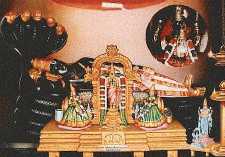
|
by Sri N. Krishnamachari February 19, 1998 |

|
![]()
This is the third stotram being covered in this series. The intent of this writeup, as in the previous ones in this sequence, is to give a very broad view of the stotram with the desire that it will give the motivation to go deeper into the stotram as the next step.
Sri Desika sings the beauty of Lord Ranganatha in this stotram. The word sopAnam means steps, and is probably derived from sa and upAyana (going near, approaching). In this stotram, Sri Desika describes Lord Ranganatha's beauty part by part starting from His lotus feet all the way up to His kirItam (The Sacred Crown). He points out in the concluding sloka that one who is desirous of yoga or union with the Lord will find it easy to climb through the steps needed for this by acquiring the necessary bhakti by chanting this stotram. This is the reason for the title 'sopAnam'.

|
| Tiruppaan Alvar |
When I read Sri Rama Desikachariar Swami's interpretations on some of the sloka-s in this stotram, I was reminded of the Alvars who imagine themselves as a friend of the Lord, or as a mother, or as a consort, etc., when they express their experience (anubhavam) of Bhagavan in the form of their compositions. In composing the Bhagavad Dhyana Sopanam, Swami Desikan's mind seems to have been in the state of a young girl in deep love with Lord Ranganatha. Thus when he describes the Lord's hands in sloka 7, he describes his mind as a she-elephant which is enjoying a tight embrace by the Lord's beautifully decorated hands. In sloka 10, where he summarizes his anubhavam of the Lord, Sri Rama Desikachariar Swami interprets Swami Desikan's thoughts as that of a young girl who is in love with the Lord and who is having this great anubhavam of the Lord first by touching His delicate feet with both her hands, then gently touching His ankles with devotion, then having the contact (sparSam) of His Sacred vaksha-sthalam or chest, then enjoying the rapture of touching His beautiful face, and then losing herself in the beauty of His kirItam.
There are a total of 12 sloka-s in the stotram. The poet in Swami Desikan is evident throughout the stotra. In the sloka where he describes the Lord's ankles, he points out that by worshipping those ankles which helped the Lord "go" fast as a messenger to the Pandavas, we can get rid of the need to "go" in the cycle of birth and death. When

|
|
Namperumaal (Srirangam utsavar) |
After the description of his anubhava of the Lord in detail, Swami Desikan summarizes his feelings of the darsanam of the moolavar and utsava-moorti in the penultimate two sloka-s. The last sloka is the phala-Sruti. This overall organization is similar to what we saw in the Dasavatara Stotram we visited last week. Just as we had one sloka in the Dasavatara stotram that summarized the ten incarnations, here we have two sloka-s that summarize the Lord's beauty. I am including these two "summary" sloka-s with their brief meanings.
pAdAmbhojam spRSati bhajate ranganAthasya janghAm
Uru-dvandve vilagatiSanair Urdhvam abhyeti nAbhim |
vakshasyAste valati bhujayor-mAmikeyam manIshA
vaktrAbhikhyAm pibati vahate vAsanAm mauLi-bandhe ||
My mind dwells on the sacred Lotus Feet of Lord Ranganatha, then moves to enjoy the darsana of His ankles, then rests well on the enjoyment of His majestic thighs, reaches His nabhI-kamalam, gets set on the vaksha-sthalam, revolves around His majestic hands, drinks the nectar of the darSanam of His beautiful face, and sets finally on His kirItam.
kAntodArair ayamiha bhujaiH kankaNajyA-kiNAnkaih
lakshmI-dhAmnaH pRthula-parighair lakshitAbhIti-hetiH |
agre kincit bhujaga-Sayanah svAtmanaivAtmanaH san
madhye rangam mama ca hRdaye vartate sAvarodhah ||
This great Lord Ranganatha who is resting on Adi-Sesha, and whose hands are beautiful, bestow all that is wished for by the devotees, has the imprint of the bangles as well as the mark of the bow-string left by bearing the bow in the process of carrying it for destroying His enemies, look like they are there to protect the vaksha-sthalam which is the dwelling place of Mahalakshmi, and carry the divine weapons that can drive away any and all fears that the devotees may be exposed to by their mere darsanam, is also presenting Himself in the form of His utsava-moorti along with His divine consorts under the Sriranga-vimaana in the heart of Srirangam as well in my heart.
In the last sloka, the phala-Sruti, the great acharya pleads to the Lord on our behalf to confer on us eternal and unswerving bhakti to help us "ascend" with ease to the level of what the great yogi-s accomplish only by intense effort.
-dAsan kRshNamAcAryan

Back to the Sri Vaishnava Home Page
Add/View comments on this page.
Mani Varadarajan Last modified: Thu Mar 4 13:56:22 PST
